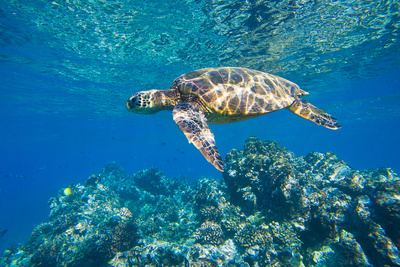Turtles in South Walton
Posted by Beaches360 Administrator on Friday, May 2nd, 2014 at 9:45am
Sea Turtle Nesting Season Begins

The beginning of May marks the start of nesting season for the area's tiniest residents. From May through October, the picturesque white sand of South Walton beaches is where endangered turtles build their nests.
The two most common species of turtles in the area are the green sea turtles and loggerheads.
Green sea turtles can weigh up to 700 pounds and are among the largest sea turtles in the world. Adult green sea turtles are complete herbivores. They much on sea grasses an algae. However, younger sea turtles also eat crabs, sponges and jellyfish. The trutles are listed as an endangered species. The average lifespan of a green sea turtle is 80 years. Unlike other types of sea turtles, the green turtle is unable to pull its head completely inside its shell.
Loggerhead turtles are known for their large heads, strong jaws and reddish-brown shells. Loggerheads are listed on the endangered species list. Eating conchs, crabs, jellyfish and fish, loggerheads are mostly carnivores. However, they also sometimes eat seaweed and sargassum. The average lifespan of a loggerhead turtle in the wild is more than 50 years.
There are certain precautions that can be taken to help protect these delicate, endangered turtles.
Everyone is encouraged to keep lights from illuminating the beach. This includes turning off balcony and porch lights and drawing the blinds at night. Only use flashlights with red film covers because the lights could disorient the turtles and cause them to move in the wrong direction. Flashlights with red film covers are available at local businesses and information centers.
Never, ever touch any sea turtles, nests or turtle eggs. The turtles are endangered and handling the turtles or their eggs in any way is a violation of both federal and state laws. However, feel free to observe the tiny creatures as they hatch and make their way to the ocean.
Another way you can protect the turtles is by keeping beaches clean. Properly dispose of all trash and remove all personal items from the beach each night.
Also, you should be sure to fill any holes you dig in the sand. This includes holes left from beach umbrellas and poles. Not only will this help keep the holes from becoming obstacles for the turtles — it will also help prevent people from being injured.
By taking a few simple safety precautions, you can help protect endangered turtles.

Leave A Comment